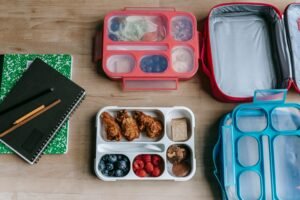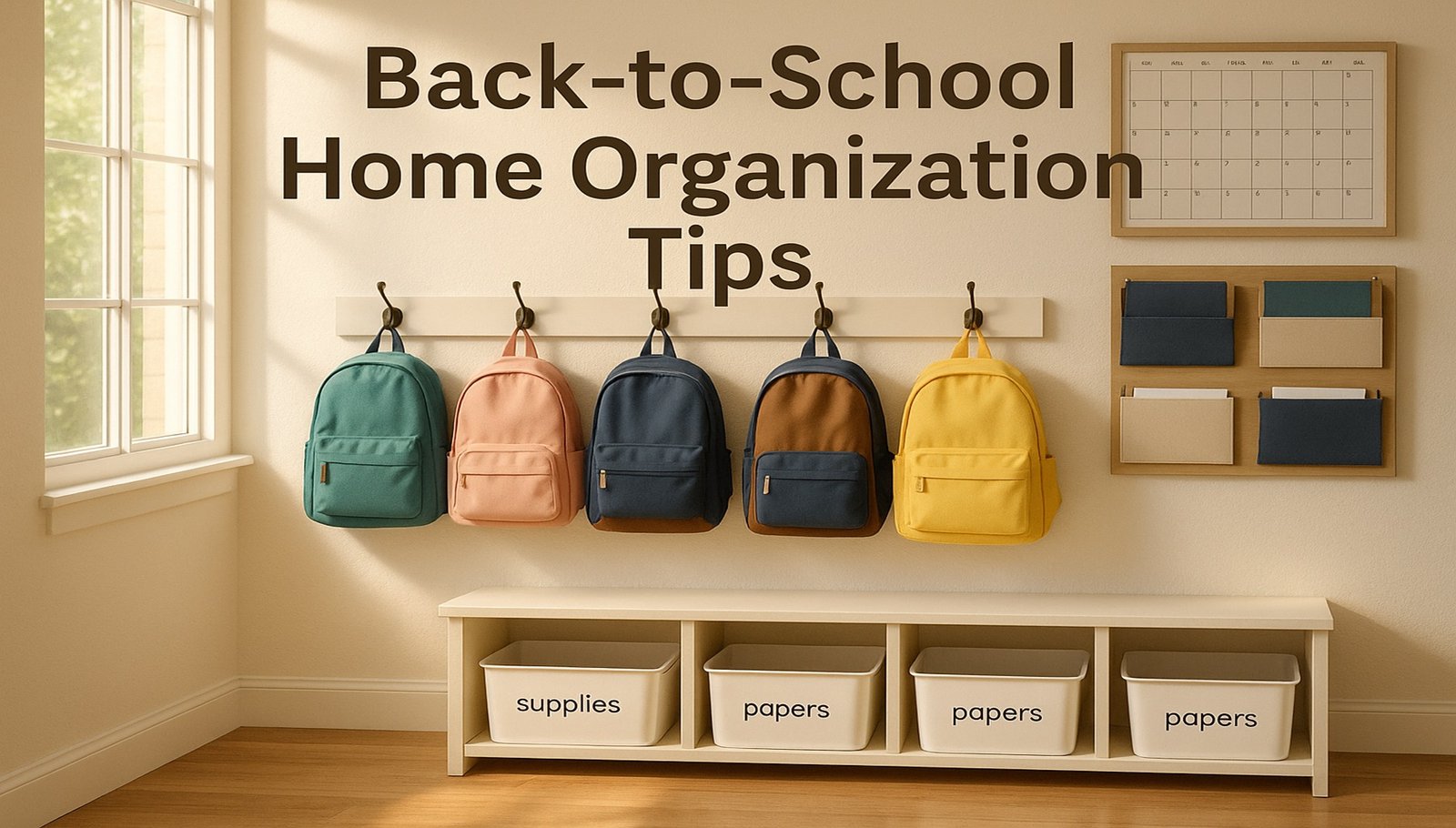As summer vacation winds down and a new school year approaches, it’s the perfect time to organize your home for school success. A little back to school home organization now can save your family tons of stress once classes begin. From back to school decluttering to creating a functional kids’ homework station, the following family organization tips will help streamline your routines. Embracing these strategies (and sprinkling in some seasonal excitement) will set your household up for a smooth transition into the busy fall schedule.

1. Start with a Back to School Decluttering Session
Before new notebooks and lunchboxes take over, kick off the season with a thorough decluttering. Go through each child’s room, study area, and closet to purge items that are no longer needed for school. Sort through last year’s school papers and artwork – file the true keepers as mementos and recycle the rest (maybe send a favorite piece to Grandma) according to clothingdonations.org. Summer gear like pool toys or camp supplies can be stored away to make room for the coming school supplies. This is also an ideal time to take inventory of your kids’ wardrobes and donate any clothes they’ve outgrown. Clearing out old clutter now creates space for new textbooks, gadgets, and sports gear that will be coming in the door each day. By decluttering ahead of time, you’ll set a clean slate and make it easier to organize everything that’s needed for the school year.
2. Designate an Entryway “Drop Zone” for School Gear
Stop the morning madness by creating a dedicated drop zone near the front door or garage entry. This is a go-to spot for backpacks, shoes, jackets, and sports equipment as kids come and go. Set up sturdy hooks at kid-friendly height for hanging backpacks and coats. Add a bench or shoe rack to corral sneakers and cleats so they’re not scattered about. You can also place bins or baskets for smaller items like hats, gloves, and umbrellas. The goal is to contain the daily school-related clutter in one organized area. For example, one organizing expert suggests using decorative bins for accessories and establishing a routine where kids put away their backpacks and gear the minute they walk in the door. An entryway drop zone ensures that every item has a home after school – and that it’s easy to grab everything when you’re racing out the door in the morning.
3. Create a Family Command Center
Take control of the family calendar chaos by setting up a central family command center. This is typically a wall or corner (often in the kitchen or entryway) where you organize schedules, paperwork, and daily reminders. Key components of a great command center include: a large wall calendar or weekly planner for events, a bulletin board or magnetic board for important papers, and labeled slots or folders for each child’s notices and permission slips. Wall hooks or a small shelf for keys, chargers, or masks can be useful too. Essentially, this becomes the family’s organization hub where everyone can see what’s coming up each week. For instance, one mom turned a small wall by the door into a command center with a calendar, mail organizer, and hooks – creating a one-stop spot for schedules and papers. Encourage the whole family to use it: pin up the school lunch menu, mark down soccer practice, and drop incoming mail or school forms in the designated tray. A command center keeps the household coordinated and minimizes the chance of missed appointments or lost paperwork.
4. Set Up a Kids’ Homework Station
Once school starts, homework time will be much smoother if your kids have a dedicated, distraction-free space to study. Create a kids homework station that fits your home – it could be a small desk in their room, a quiet corner of the living room, or even the kitchen table as long as it’s set up for focus. Make sure the area has good lighting and a comfortable chair. Stock this homework station with all the essentials within arm’s reach: pencils, pens, chargers for devices, paper, scissors, calculator – whatever your students might need to tackle assignments. Consider organizing supplies in a desk organizer or drawer so that everything has a place. According to Good Housekeeping, having a clean, clutter-free desk and keeping supplies handy can help kids dive right into their work without distraction. A small plant or some fun decor can make the space inviting (one designer even suggests adding greenery to boost the mood). Whether it’s a standalone desk or just a portion of the dining table each evening, establishing a defined homework zone signals to kids that it’s time to focus on schoolwork.
5. Organize School Supplies with a Homework Caddy
To complement the homework station, create a portable homework caddy for school supplies. This is especially handy if your child doesn’t have a fixed desk and does homework at the kitchen table or other shared space. Use a small bin or caddy with compartments to hold supplies like pencils, markers, crayons, glue sticks, scissors, etc. The beauty of a homework caddy is that kids can easily grab it when it’s study time and then stow it away when they’re done. It keeps all those supplies in one place instead of scattered around the house. You can buy a simple caddy or even repurpose a utensil holder or shower caddy for this purpose. Fill it with the tools they’ll need to complete assignments (sharpened pencils, erasers, calculator, highlighters). One clever idea from an organization blogger is to use a utensil caddy to corral homework supplies, making it easy to transport and then tuck back into a cabinet when not in use. With a homework supply caddy, your kids won’t waste time hunting for a pencil or sharpener – everything will be neatly organized and ready to go.
6. Prepare a Lunch-Packing Station in the Kitchen
Streamline those busy mornings (and save yourself from last-minute lunch scrambles) by setting up a small lunch-packing station. Dedicate a section of your kitchen or pantry to all things lunch-related. For example, clear one shelf or drawer for lunch bags, food containers, thermoses, and water bottles. Keep reusable containers and lids together so they’re easy to grab. In the pantry, designate a bin for school snacks and lunch items that are approved for the week – this could include granola bars, crackers, dried fruit, etc. In the fridge, you might have a specific spot for lunch components like pre-cut veggies, cheese sticks, or yogurt. The idea is to organize these items so that packing lunch (or having the kids pack their own) is quick and efficient. You can even involve your children by letting them help restock their snack bin or choose items for their lunches in advance. Packing lunches the night before and refrigerating them is another pro tip to reduce morning chaos. By having a lunch station, you’ll avoid the mad dash of searching the kitchen for sandwich bags or that missing lunchbox at 7 AM. Plus, you ensure a bit of healthy variety is always on hand for your kids’ meals.

7. Plan Outfits and School Gear Ahead of Time
Eliminate the daily “what do I wear?” scramble (and the dreaded missing shoe scenario) by organizing your kids’ school outfits in advance. Some families swear by planning a week’s worth of outfits every Sunday. You can use a labeled hanging organizer in the closet with slots for each day of the week, so your child’s clothes for Monday through Friday are pre-selected and ready. This way, each morning they can quickly grab that day’s outfit without debate or delay. Don’t forget to include socks, underwear, and any accessories or uniforms needed for specific days (like gym clothes or band attire). Likewise, have your kids pack their backpacks each evening with the next day’s necessities – completed homework, notebooks, sports gear, signed permission slips, etc. Place the packed bag by the entryway drop zone so nothing is forgotten in the morning rush. By preparing clothing and gear ahead of time, you reduce decision fatigue and ensure everyone leaves the house on time. As Good Housekeeping notes, giving everything in your closet a designated place (using bins and labels) contributes to a seamless morning routine where little ones can get dressed and out the door without fuss.
- Weekly Closet Organizers:Our hanging closet organizer has six layers (11.81″D x 11.81″W x 48.8″H) and includes a set of colorful labels for each day of the week, allowing you to plan your outfits in advance
8. Label Everything (Supplies, Clothing, and Containers)
When the whole family is juggling backpacks, lunch boxes, jackets, and dozens of school supplies, it’s easy for things to get misplaced. That’s why one of the simplest organization hacks is to label, label, label everything. Use a label maker or write names on items so that each child knows what belongs to them – and lost items have a better chance of coming home. You can label inside jacket collars, water bottles, lunch containers, notebooks, pencil cases, and more. For younger kids, consider fun personalized name tags or stickers that go on their gear. According to experts, clearly labeled supplies and clothing help children keep track of their belongings amid the back to school hustle. Labeling also aids you in keeping bins and storage areas organized (e.g., a bin labeled “Art Supplies” or a folder labeled “Math Homework”). If you have multiple kids, assign each child a color for their notebooks, folders, or storage bins – this color-coding combined with labels can be a lifesaver for family organization. A little effort with labeling upfront can prevent countless headaches later searching for whose binder is whose.
- Ideal For Small Office, Home Office, and Home Organization: a mobile label maker to keep homes, small offices, and workspaces tidy and organized. Powered by 6 AAA batteries or optional AC adapter (each sold separately)
9. Establish Consistent Routines for Mornings and Evenings
All the home organization in the world won’t stick if you don’t pair it with consistent family routines. Take some time to map out how mornings and evenings should flow during the school week. For example, create a morning routine checklist: wake up at a set time, eat breakfast, get dressed (from those pre-planned outfits), grab backpack from the drop zone, and head out the door by X time. In the evenings, have a routine for unpacking bags, placing lunchboxes by the sink, doing homework at the homework station, then some relaxation or family time. Post these routines as a checklist for kids to follow – visual reminders can help, especially for younger children who thrive on structure. You might use a whiteboard or a printed chart that kids can tick off (some parents even laminate a checklist so it can be re-used daily with a dry-erase marker). Incorporating consistent bedtimes and wake-up times is important too, so everyone gets enough rest. To keep things on track, consider using timers or alarms in the morning (for instance, a gentle alarm 10 minutes before it’s time to leave the house, as Good Housekeeping suggests, to keep everyone on schedule). With established routines, your organized home systems – from the command center to the drop zone – will function even more smoothly, because everyone knows what they’re supposed to be doing and when.
10. Involve the Kids and Maintain the System
Lastly, make back to school home organization a family affair. Encourage your children to take ownership of their spaces and stuff. Little ones can help by putting toys away or choosing their outfit for the next day, while older kids can be responsible for keeping their homework station tidy or updating the family calendar with their activities. Involving kids in the organizing process not only lightens your load, but also teaches them valuable life skills and accountability. For instance, have your kids empty their backpacks each afternoon and sort papers into the command center files, or let them decorate and label their own supply caddy. When kids have helped set up an organized system, they’ll be more likely to stick with it. Be sure to model the behavior as well – if parents consistently hang up keys on the hook and sort mail into the right folder, kids will follow suit. Schedule a quick family tidy-up time each week to reset any areas that have gotten messy. The key is to maintain these systems throughout the school year: a few minutes each day spent putting things back in their places will prevent clutter from exploding. With everyone pitching in and a commitment to keeping the home organized, your back to school routines will stay on track all year long.
Don’t forget to check our Top 5 Trendy Reusable Water Bottles
FAQ: Back-to-School Home Organization
Q: When should we start organizing our home for back to school?
A: Ideally, begin your back to school home organization a few weeks before the first day of school. Late summer (early August) is a great time for back to school decluttering – clean out closets, sort old school papers, and set up organization stations before the busy school routine starts. Getting a head start means you won’t be scrambling at the last minute, and you can enjoy the end of summer knowing your home is ready for the fall.
Q: How can I get my children involved in organizing for the new school year?
A: Making kids part of the process is key to a successful system. Turn organization into a fun activity: for example, have them help label their notebooks or decorate their homework station. You can let each child choose a color for their storage bins or hang a personalized name tag on their backpack hook. Give age-appropriate responsibilities, like having your child lay out their outfit each night or check off their own morning routine chart. When kids contribute to creating an organized space, they take more pride in maintaining it.
Q: What are some family organization tips to keep our home tidy during the school year?
A: Consistency and communication are vital. Establish daily routines (morning and evening) so everyone knows what to do – such as a set homework time, a regular spot for backpacks, and a habit of packing lunches or bags the night before. Keep using your command center to track events and tasks – maybe review the family calendar together every Sunday. Also, schedule small weekly touch-ups: for instance, Sunday evening can be “reset” time when kids refill their homework caddies, parents review upcoming appointments, and everyone makes sure uniforms or supplies for the week are ready. By regularly resetting and following the systems you’ve put in place, you prevent clutter from piling up. And remember to celebrate successes – if the first month of school goes smoothly thanks to everyone’s efforts, acknowledge it as a family victory!









